This page created September 1997, updated 11th November 2003Any corrections, additional information or news gratefully welcomed.
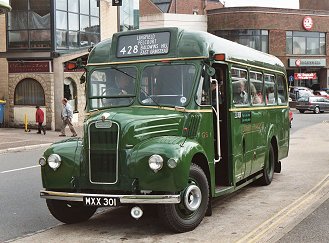
ContentsGS1 at King Street, during the East Grinstead running day in April 2003.At the start of the fifties London Transport's Country Area found itself with a need to replace its ageing fleet of Leyland Cubs. The rear-engined Cubs built just before the war were not deemed to be the required solution, and the new RF class were too large for the little country lanes that were served by these buses. (Later, of course, the natural widening of lanes by increased traffic meant that many such routes could be operated by RFs and RTs.) Another important factor was that the Cubs were the only remaining LT buses that were allowed to be used for one person operation, which was still restricted by regulations to twenty seaters. Replacement by crewed buses would be hopelessly uneconomic on these routes. The answer was an updated normal-control Cub-style small bus: the Guy Special. In 1952 Guy produced chassis for the 84 buses, which received ECW bodywork with a family likeness to the RF (especially at the rear!). By agreement with the licensing authorities, they seated 26, but were still allowed to be single-manned. Sliding ventilators were fitted to windows rather than the standard wind-down type.
Power was provided by a Perkins P6 diesel engine,
tucked under a bonnet of the same pattern as the contemporary Thames lorries.
This opened vertically, like an alligator,
requiring a divided grille at the front.
This was topped by Guy's Indian figurehead,
which was usually suitably embellished.
Into serviceSixty-five Guys entered service in the last three months of October 1953, with another following in January 1954. They ousted the pre-war Leyland Cubs and the last remaining rear-engined CRs. There was speculation as to what would happen to the remaining eighteen. Would they go to the Central Area to replace the lightweight 1T1s over Walton Bridge? No, they wouldn't! RFs went there instead, as the bridge restrictions were relaxed.
The answer soon presented itself, as they began to replace
10T10s or
15T13s on rural routes.
The latter enlarged their sphere of operations and took over from the remaining 10T10s around the system.
That still left a handful of GSs in store at Garston, but gradually work was found for them
as the New Towns developed, although GS84 did not start work until January 1956.
GS operations were grouped around a few garages, with a scattering of the remainder:
Other garages used just one or two GSs to service a single route:
Some routes required GS operation because of some geographical oddity. The 7.5 ton bridge on the 448 at Gomshall was one such. RFs could cross but only empty! GSs were lighter, at 4 tons. Others had GSs because their meagre capacity was all that was required, on routes like the 308A out of Hertford and one person operation was the economic necessity.ServiceSome of the GS routes stayed more or less the same during their tenure. Others developed as the New Towns spread.Harlow was a considerable development, eventually gaining a new LT garage in May 1963 at the expense of Epping. GS routes in what had been a rural area were modified. Some were cropped or diverted. Some were replaced by higher capacity buses as now appropriate. Crawley also saw substantial development. GS buses were drafted in to replace a collapsed rural operator on the 852 from Crawley to Horsham and on to Ewhurst, only to face criticism from other independents for doing so. The 852 was quickly pruned back to the LT area, but Crawley continued to use the type, sometimes as extras to increase peak capacity on some routes. The Amersham and Northfleet routes were adapted over the years as ways were sought to get the best value out of the little buses. In places routes were tried briefly: Grays had two attempts, with the short-lived 372 service in the Belhus Estate, and later with the 399 through the Dartford tunnel to Dartford, neither of which made much impact. Chelsham had a fling with the 400 between New Addington and Warlingham Park Hospital, a venture that might have worked but for the 1958 strike and subsequent retrenchment. Likewise Dunton Green tried a 479 service from Orpington to Biggin Hill, that later became a successful minibus route with another operator. GS are associated with many of the prettier parts of the London outskirts, where stockbrokers' wives used the little buses to get to the shops in the days before two-car families. GS1 climbs out of Chesham, and GS62 rests between the pub and church at Beaconsfield (both October 2003)DeclineMost lasted into the sixties, but in 1962 the new coach Routemasters produced a glut of RF's, which displaced the smaller buses. The RFs were also single-manned by now, and standard bus operating lore said that you always used the largest possible vehicle: no minibus policy then! In October 1962 there were mass withdrawals, with Amersham, Chelsham and Epping losing their entire allocations. However, the need for small buses persisted in pockets, and after a reshuffle some served on, whilst others went for sale.During the remainder of the sixties the buses were gradually sold off or stored. Some fresh tasks were found for them, as peak extras and staff buses, and some routes reverted to GS operation from RF as patronage declined. In 1967 they almost got to work for the Central Area. Elmers End Railway Bridge suddenly acquired a stringent weight restriction, necessitating a long diversion on the RT-operated 54 route. Consideration was given to using a pair of GSs to bridge a gap in RT services between Elmers End Garage and Longheath (Long Lane). Two GSs would be required. GS50 was reported repainted red (panels still exist). However, the scheme did not materialise, a long diversion being used instead, and by August 1967 GS50 was certainly sitting in store in Abbey Wood Garage wearing dusty green livery, prior to sale. In 1970 most of the survivors passed to London Country, but not all: five were retained by LT for use as staff buses, carrying workers to and from Chiswick and Aldenham works from south-east London (Abbey Wood and Plumstead) and the Croydon/North Surrey area (Reigate), still in green livery. The last was Abbey Wood's GS52, withdrawn in April 1974. The last scheduled ordinary public service was by London Country on 29th March 1972, on the 336A from Garston Garage, using regular GS42 plus spare GS33 (followed by an unscheduled 309 journey back to Garston from Rickmansworth). AfterlifeThe type was welcomed by other small bus operators on the London periphery, notably Tillingbourne Valley in the Guildford area, which had taken over the Guildford GS routes in 1962. Southern Motorways was another user with several of the class for services west of Chichester along the coast. West Bromwich Corporation bought a pair, one modified for elderly people transport, and the other as a bus, which later became part of the West Midlands PTE fleet!They were also popular as company transport, particularly by fruit and poultry farmers, and contractors. British Railways used a couple. London Transport retained one as its Civil Defence training vehicle, replacing an ancient Q, and their St John's Ambulance Brigade converted one to a mobile first aid post. Some were bought privately for use as caravans. Many survived into preservation and may be seen at rallies, or even ridden in public services. The Country Bus Rallies group organise three or four events a year which use the little buses, recreating the routes they used fifty years ago, and allowing the public to ride free. They get a warm response from people, who obviously hold them in affection. Others have been - or are - used as buses by companies providing ramblers' or nostalgia services, such as London Country's erstwhile heritage bus services in Surrey, and Nostalgiabus. GS2 was one of several GS buses bought by Southern Motorways after their LT days were over. GS2 survived ito preservation and continued to wear the maroon and red for some years. It is seen at Tewin on the 2002 Hertford Running Day, working along the 388. In early 2003, its fiftieth anniversary, the bus was returned to LT green, and is seen at the stop on Cholesbury Common during the October 2003 Chesham Running Day.Histories of GS buses are given on a separate sheet (includes many more photos). So is the list of photographic references
|

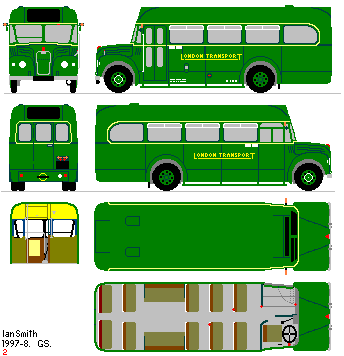
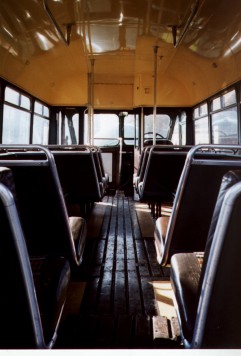
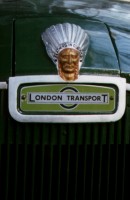
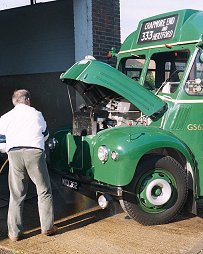
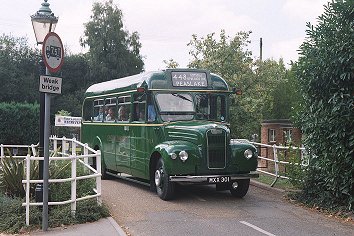
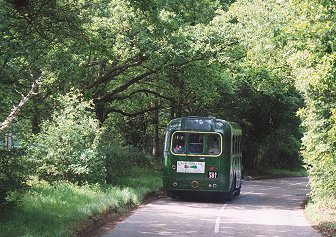
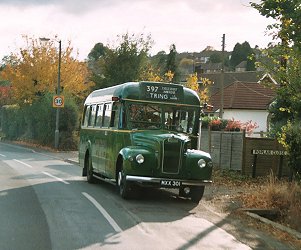
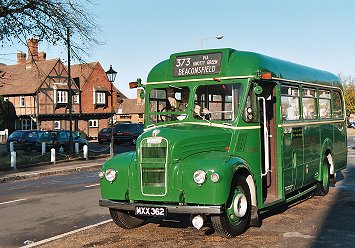
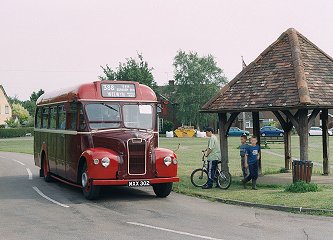
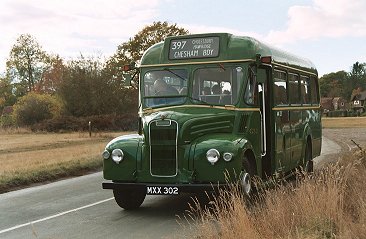
 Bus Stop
Bus Stop Contents.
Contents. bus history (& more pics)
bus history (& more pics)